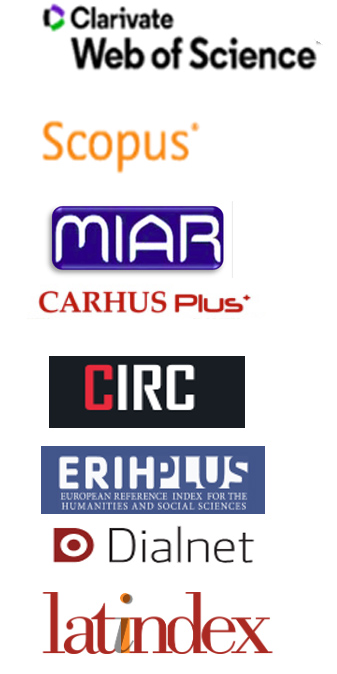Imagem técnica multi-banda na investigação do processo de execução das pinturas. O caso do retrato de Carlos IV, de Francisco de Goya
Resumo
A imagem técnica multi-banda (MBTI) é amplamente utilizada como um método eficaz para examinar obras de arte. Embora as várias técnicas que o compõem tenham a sua própria entidade, quando usadas em conjunto, fornecem muito mais informações ao confrontar os vários resultados. O principal objetivo deste trabalho é mostrar o seu uso na compreensão material, processual e criativa de um retrato do Rei Carlos IV. Mais especificamente, a imagem técnica multi-banda tem sido usada aqui para ajudar na reconstrução do processo pictórico, ao revelar dados relacionados com a criação e execução da pintura (ductus e pinceladas, alterações, desenho subjacente e arrependimentos, repintes, identificação de pigmentos, etc.). Neste estudo de caso, esta informação serve para aprofundar o processo de trabalho do pintor, revelando algumas características que o tornam único, e, permitindo, finalmente, a correta identificação e atribuição do retrato.
Downloads
Referências
COSENTINO, A. (2013) “A practical guide to Panoramic Multispectral Imaging”, e-Conservation Magazine, 25, 64–73.
COSENTINO, A. (2014) “Identification of pigments by multispectral imaging a flowchart method”, Heritage Science, 2:8. http://www.heritagesciencejournal.com/content/pdf/2050-7445-2-8.pdf
COSENTINO, A; CAGGIANI, M.C.; RUGGIERO,G.; SALVEMINI, F. (2014) “Panoramic Multispectral Imaging: Training and Case studies”, Belgian Association of Conservators Bulletin, 2nd Trimester, 7–11.
COSENTINO, A; STOUT S. (2014)”Photoshop and Multispectral Imaging for Art Documentation”, e-Preservation Science, 11, 91–98. https://www.google.com/url?sa=t&rct=j&q=&esrc=s&source=web&cd=1&ved=0ahUKEwjqyqO31OvaAhWL16QKHaR6C8UQFggsMAA&url=http%3A%2F%2Fwww.morana-rtd.com%2Fe-preservationscience%2F2014%2FePS_2014_a11_Cosentino.pdf&usg=AOvVaw3CRyiTOwtseYGTA-2Av55c
COSENTINO, A. (2015 a) “Imaging Multispettrale low-cost con filtri interferenziali”, Archeomatica, 2, 12-17.
COSENTINO, A. (2015 b)“Multispectral Imaging of Pigments with a digital camera and 12 interferential filters”, e-Preservation Science, 12, 1-7).
COSENTINO, A. (2015 c) “Multispectral imaging system using 12 interference filters for mapping pigments”, Conservar Património 21, 25-38.
COSENTINO, A. (2015 d) “Effects of Different Binders on Technical Photography and Infrared Reflectography of 54 Historical Pigments”, International Journal of Conservation Science, 6 (3), 287-298. https://chsopensource.org/2015/09/11/effects-of-different-binders-on-technical-photography-and-infrared-reflectography-of-54-historical-pigments/
COSENTINO, A. (2015 e) “Practical notes on ultraviolet technical photography for art examination”, Conservar Património 21, 53-62.
COSENTINO, A. (2015 f) “Multispectral imaging and the art expert”, Spectroscopy Europe, 27 (2) 6-9.
COSENTINO, A. (2016) “Infrared Technical Photography for Art Examination”, e-Preservation Science, 13, 1-6.
CUCCI ,C; DELANEY, J. K, PICOLLO, M. (2016) “Reflectance Hyperspectral Imaging for Investigation of Works of Art: Old Master Paintings and Illuminated Manuscripts”. Accouns of Chemical Research, vol. 49, 2070-2079.
CUCCI, C., BRACCI, S., CASINI, A., INNOCENTI, S., PICOLLO, M., STEFANI, L.& SCUDIERI, M. (2018). The illuminated manuscript Corale 43 and its attribution to Beato Angelico: Non-invasive analysis by FORS, XRF and hyperspectral imaging techniques. Microchemical Journal, 138, 45-57.
GABALDÓN, A. (1999) Técnicas de Análisis Físico: Radiografía y Reflectografía de Infrarrojo, aplicadas al estudio de los bienes muebles. Arbor, 1999, vol. 164, no 645, p. 27. http://search.proquest.com/openview/16f5d24490d437c820c25c4c9bcc3d9e/1?pq-origsite=gscholar&cbl=1818224
GARRIDO, C. Aplicación de la metodología científica al estudio de la pintura. En Arte: materiales y conservación. Fundación Argentaria, 1998. p. 41-65. http://mail.foronuclear.org/images/stories/recursos/zona-descarga/periodistas/2013/Aplicacion_metodologia_cientifica_estudio_pintura_Carmen_Garrido_Museo_Prado.pdf
MARILENA, T. (ed.) (2017). Salve Mater. L’Annunciazione di Beato Angelico a San Marco. The Annunciation by Fra Angelico at San Marco. Quanderni del Museo di San Marco. Firenze: Sillabe.
MATTEINI, M.; MOLES, A. (2001) Ciencia y Restauración. Método de investigación. Sevilla: Editorial Nerea, S.A.
MOUTSATSOU A., SKAPOULA D., DOULGERIDIS M., “The Contribution of Transmitted Infrared Imaging to Non-Invasive Study of Canvas Paintings at the National Gallery – Alexandros Soutzos Museum, Greece”, in e-conservation magazine, 22, 2011, pp. 53-61. http://www.e-conserva-tionline.com/content/view/1038
PAMART, A., GUILLON, O., FARACI, S., GATTET, E., GENEVOIS, M., VALLET, J. M.; DE LUCA, L. (2017). Multispectral Photogrammetric Data Acquisition and Processing Forwall Paintings Studies. The International Archives of Photogrammetry, Remote Sensing and Spatial Information Sciences, 42, 559.
PELAGOTTI, A., DEL MASTIO, A., DE ROSA, A., & PIVA, A. (2008). Multispectral imaging of paintings. IEEE Signal Processing Magazine, 25(4), 27-36.
PINNA, Daniela; GALEOTTI, Monica; MAZZEO, Rocco. Scientific Examination for the Investigation of Paintings. A Handbook for Conservator-restorers. Firenze: Centro Di, 2009.
POLDI, G.; VILLA G. C. (2006). Dalla conservazione alla storia dell’arte. Riflettografia e analisi non invasive per lo studio dei dipinti. Pisa: Edizioni della Normale.
PUIG, I; COMPANY, X; GARRIDO, C.; HERRERO-CORTELL, M. (2016) Francisco de Goya Carlos IV. Protrait of King Carlos IV. CAEM-Universitat de LLeida: LLeida.
RORIMER J.J. (1931) “Ultraviolet rays and their use in the examination of works of art ”in Metropolitan Museum of Art, New York; 1st Ed. 1931
VAN ASPEREN DE BOER, J. (1969) “Reflectography of paintitngs using an Infrared Vidicon Television System”. En: Studies in Conservation, Vol. 14,. 96-118.
VITORINO, T., CASINI, A., CUCCI, C., MELO, M. J., PICOLLO, M., & STEFANI, L. (2015). Non-invasive identification of traditional red lake pigments in fourteenth to sixteenth centuries paintings through the use of hyperspectral imaging technique. Applied Physics A, 121(3), 891-901.
WARDA J. (ed.), FREY F., HELLER D., KUSHEL D., VITALE T., WEAVER G, “AIC Guide to Digital Photography and Conservation Documentation”, 2nd Edition, in American Institute for Conservation of Historic and Artistic Works, 2011.4.
Os autores conservam os direitos de autor e de propriedade intelectual e garantem à revista Ge-Conservación o direito de edição e publicação do trabalho, sob a Creative Commons Attribution License. Este permite a partilha do trabalho, por outros, com o reconhecimento da autoria do trabalho e da publicação inicial nesta revista.
Os artigos podem ser utilizados para fins científicos e formativos, mas nunca com fins comerciais, expressamente, sancionados por Lei.
A informação existente nos artigos é da exclusiva responsabilidade dos autores.
A revista Ge-Conservación e os autores podem estabelecer, em separado, acordos adicionais para a distribuição não exclusiva da versão da obra publicada na revista (por exemplo, colocá-la num repositório institucional ou publicá-la em livro), com o reconhecimento da sua publicação inicial nesta revista.
É permitido e incentivado aos autores difundirem os seus trabalhos, electronicamente (por exemplo, em repositórios institucionais ou no seu próprio site) depois da sua publicação na revista Ge-Conservación, já que pode dar lugar a intercâmbios produtivos, assim como a citações mais amplas e mais cedo dos trabalhos publicados pelo autor.
Os dados pessoais fornecidos pelos autores são utilizados, unicamente, para os fins da revista e não serão proporcionados a terceiros.









